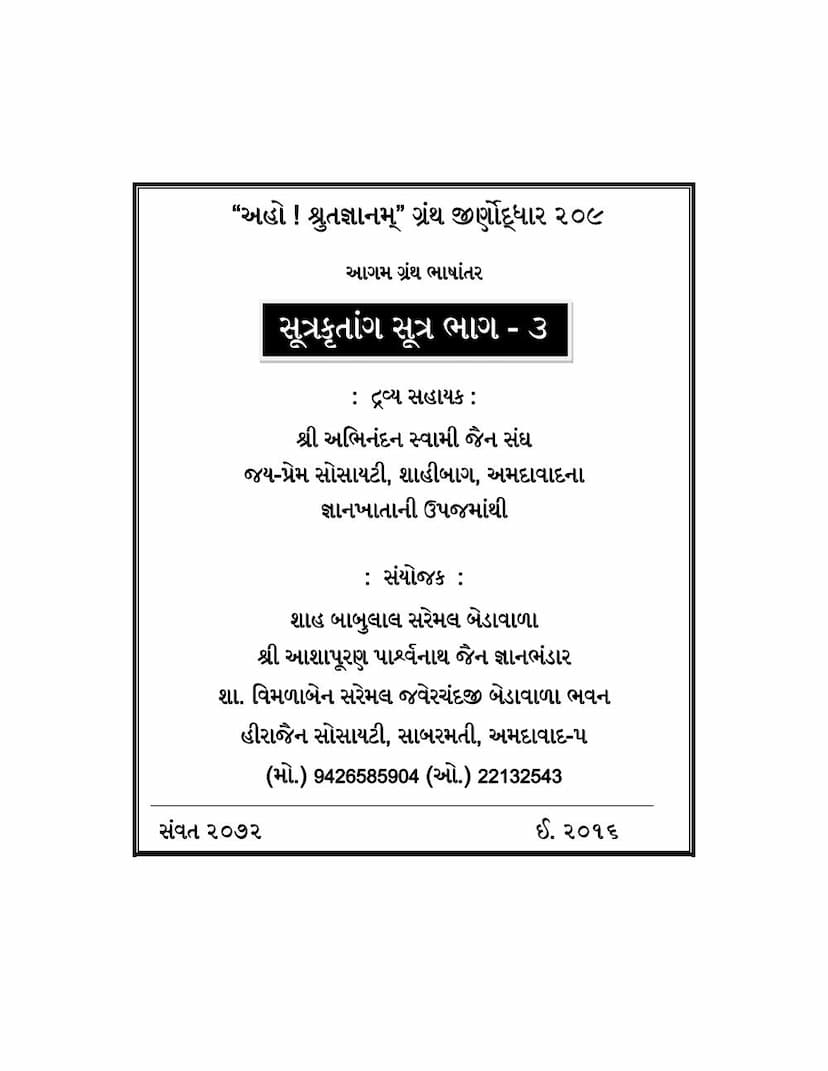Sutrakritanga Sutra Part 03
Added to library: September 2, 2025

Summary
Here's a comprehensive summary of the provided Jain text, focusing on the content and context presented in the pages:
Sutrakritanga Sutra, Part 03, authored by Manekmuni, published by Mohanlal Jain Shwetambar Gyanbhandar.
This document appears to be a part of a larger project titled "Aho Shrutgyanam Granth Jirnyauddhar" (Reconstruction of Knowledgeable Scriptures), which aims to preserve and digitize ancient and rare Jain texts. The provided pages (1-11) detail the publication information and a catalog of scanned books, predominantly in Gujarati and Sanskrit, related to Jainism, philosophy, arts, architecture, and various other subjects.
Key Information from the Initial Pages (1-10):
- Title: Sutrakritanga Sutra, Part 03.
- Author: Manekmuni.
- Publisher: Mohanlal Jain Shwetambar Gyanbhandar.
- Project: "Aho Shrutgyanam Granth Jirnyauddhar" (Reconstruction of Knowledgeable Scriptures). This project, supported by various Jain sanghs and individuals, focuses on scanning rare and out-of-print books and creating DVDs or making them available online (www.ahoshrut.org).
- Catalog: Pages 2-10 provide an extensive catalog of digitized books, listing their titles, authors/commentators, and page numbers. The catalog covers a wide range of topics, including:
- Jain Scriptures and Commentaries: Nandi Sutra, Uttaradhyayan Sutra, Siddh-hem Shabdanushasan, Achalanga Sutra, Suyagadanga Sutra, etc.
- Philosophy and Logic: Nyay Pravesh, Tattvopaplavasimha, Tarka Rahasya, etc.
- Arts and Architecture: Shilpashastra, Vastushastra, various architectural texts like Prasad Tilak, Prasad Manjari, Shilpa Ratnam, etc.
- Literature and History: Various historical accounts, poems, devotional texts (stotras), and literary works.
- Astrology and Allied Sciences: Jyotish, Samudrik Shastra, etc.
- Grammar and Linguistics: Prakrit Vyakarana.
- Sponsors/Contributors: The project acknowledges contributions from various Jain societies like Shri Abhinandan Swami Jain Sangh, Jay-Prem Society, Ahmedabad, and individuals like Shah Babulal Somal Bedawala.
Summary of the Textual Content (Pages 11-48):
The provided text, starting from Page 11, delves into the commentary and essence of specific chapters of the Sutrakritanga Sutra. The summary focuses on the eighth chapter, "Virya Adhyayan" (Chapter on Energy/Strength), and the ninth chapter, "Dharma Adhyayan" (Chapter on Dharma/Righteousness).
Summary of the Eighth Chapter: Virya Adhyayan (Chapter on Energy/Strength):
- Purpose: To explain the concept of "Virya" (strength, energy, power) and its different types, especially in the context of spiritual practice for monks and nuns.
- Types of Virya: The chapter categorizes Virya into three types:
- Bal Virya (Child-like Energy): Energy used for negative or misused purposes.
- Pandit Virya (Wise Energy): Energy used correctly and purposefully.
- Bal Pandit Virya (Mixed Energy): Energy used partially correctly and partially otherwise, often applicable to householders.
- Sources of Virya: The text discusses physical strength, sensory power, and spiritual strength derived from meditation and tapasya.
- Categories of Virya: It further elaborates on:
- Dravya Virya (Material Energy): The inherent energy in living beings (dvipada, chatushpada, apada) and non-living things (food, weapons, armor).
- Bhava Virya (Internal/Spiritual Energy): This is the primary focus, encompassing mental fortitude, steadfastness in practice (Dhriti), courage (Dheer), renunciation (Shiidiyata), patience (Kshama), and inner strength. It emphasizes the importance of using spiritual energy wisely, avoiding misuse, and focusing on self-improvement and spiritual advancement.
- Misuse of Virya: The text warns against misusing energy for sinful activities, attachment, or worldly desires.
- Virtuous Use of Virya: The correct application of Virya is linked to knowledge, tapasya, meditation, and adherence to the path of liberation.
- Concepts of Sambhav and Sambhavya: The text differentiates between inherent capabilities (Sambhav) and potential capabilities that can be developed (Sambhavya).
- Importance of Discipline: It highlights the necessity of controlling the mind, senses, and speech for the proper cultivation of Virya.
- Ethical Conduct: The chapter stresses the importance of non-violence (ahimsa), truthfulness, non-stealing, celibacy, and non-possession as integral to the proper use of Virya.
- Relevance for Monastics and Laypersons: While primarily aimed at ascetics, the principles discussed are also relevant for lay Jains in their pursuit of spiritual merit.
Summary of the Ninth Chapter: Dharma Adhyayan (Chapter on Dharma/Righteousness):
- Connection to Virya: This chapter builds upon the concept of Virya, emphasizing that the proper use of energy leads to Dharma. Dharma is presented as the path to liberation.
- Dharma as Righteous Action: Dharma is defined as consistent practice of knowledge, perception, and conduct, leading to spiritual progress.
- Types of Dharma:
- Laukik Dharma (Worldly Dharma): Actions performed with worldly intentions or rituals.
- Lokottar Dharma (Transcendental Dharma): The true spiritual path of knowledge, perception, and conduct that leads to liberation.
- Key Principles of Dharma: The chapter discusses the importance of:
- Knowledge (Jnana): Understanding the true nature of reality.
- Conduct (Charitra): Living according to ethical principles and vows.
- Discipline (Sanyam): Self-control and restraint.
- Tapasya (Austerities): Practices for purifying the soul.
- Equanimity (Samata): Maintaining balance in all circumstances, free from attachment and aversion.
- Non-violence (Ahimsa): The supreme principle, extending to all living beings.
- Renunciation (Tyaga): Giving up worldly possessions and attachments.
- Avoiding Negative Influences: The text advises against associating with those who have fallen from the path (kushil) or who promote unrighteousness.
- The True Path: The chapter emphasizes that true Dharma lies in the inner purification of the soul and the diligent practice of the principles that lead to the cessation of karma and liberation.
- Ethical Framework: It outlines how to discern right from wrong and the importance of following the teachings of the enlightened ones (Jinas).
- The Goal: The ultimate aim of Dharma is to achieve Moksha (liberation) from the cycle of birth and death.
Overall Purpose of the Document:
The initial pages showcase a significant effort by the Jain community to preserve and make accessible their scriptural heritage. The core of the provided text focuses on explaining profound philosophical and ethical concepts from the Sutrakritanga Sutra, particularly the practical application of energy and the nature of true Dharma, guiding the reader towards spiritual growth and liberation.